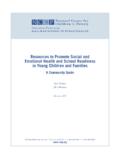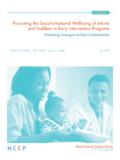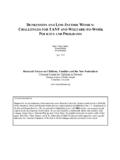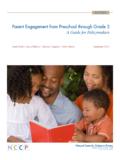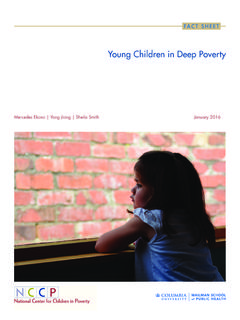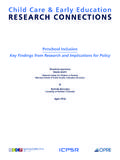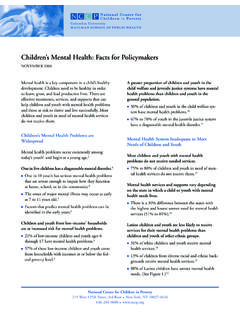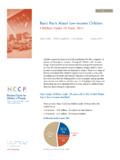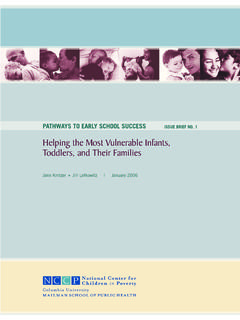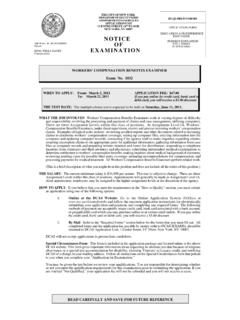Transcription of Examining Health Disparities by Race and Ethnicity …
1 REPORTWho Are America s Poor Children? Examining Health Disparities by Race and EthnicityDavid Seith | Courtney Kalof July 2011 The National Center for Children in Poverty (NCCP) is a leading public policy center dedicated to promoting the economic security, Health , and well-being of America s low-income families and children. Using research to inform policy and practice, NCCP seeks to advance family-oriented solutions and the strategic use of public resources at the state and national levels to ensure positive outcomes for the next generation. Founded in 1989 as a division of the Mailman School of Public Health at Columbia University, NCCP is a nonpartisan, public interest research Are AMeriCA S Poor CHildreN?
2 Examining Health Disparities by race and ethnicityDavid Seith, Courtney KalofCopyright 2011 by the National Center for Children in PovertyAuthorSDavid Seith is a research analyst on the Family Economic Security team at NCCP. his work at four leading national research centers over the past 10 years has focused on the implementation and outcomes of welfare reform for low-income families and communities. he is a candidate for the executive master s of public policy and administration at Columbia university s School of International and Public Kalof is a graduate student intern at NCCP and a candidate for an MPh in the Department of Health Policy & Management at Columbia university Mailman School of Public Health .
3 She is specializing in healthcare management and plans to work in the field of chronic disease prevention and managementACKNowlEDgMENtSthis research was supported by funding from the Annie E. Casey Foundation. the authors would like to thank Curtis Skinner and Elizabeth Isakson for their thoughtful comments on earlier drafts. Special thanks also to Morris Ardoin, Amy Palmisano, and telly Are America s Poor Children? Examining Health Disparities by Race and Ethnicity 3 Who Are America s Poor Children? Examining Health Disparities by Race and EthnicityDavid Seith | Courtney Kalof July 2011introductionGood Health in childhood both reflects and predicts full social and economic participation.
4 Conversely, so-cial divisions by race and income are often associated with Health Disparities , which inhibit children from achieving their full potential. Although many would agree that Health is a fundamental right, children subject to exclusion by race and class are less likely to enjoy this earlier report in the NCCP Who are America s Poor Children? series examined child Health dispari-ties by poverty status. In the introduction to that report two points were made. First, the relationship between socioeconomic status and Health is one of the most robust and well documented findings in social science.
5 2 Second, the relationship is also reciprocal, as poverty detracts from resources used to maintain Health , while poor Health detracts from the education-al and employment paths to income report goes one step further to consider Health Disparities among poor children by race and Ethnicity . As in the earlier report, it identifies a list of publicly available indicators found in the National Health Interview Survey (NHIS) and the National Health and Nutrition Examination Survey (NHANES). It exam-ines selected Disparities in six domains of Health risk and Health status: family composition and poverty, food insecurity, environmental conditions, Health insurance coverage, access to healthcare services, and Health offers a short introduction to a dozen indicators, explaining how each reflects one of the six dimensions of heath and how public policies might help to reduce relevant Disparities .
6 Intended for a generalist audi-ence, this report summarizes and references primary research the leading causes of mortality have changed over time in the most developed countries, from infectious diseases (such as tuberculosis and in-fluenza) to chronic diseases (like heart disease, cancer, and stroke) those who are socially marginalized by race and class continue to be at substantially higher risk for poor Center for Children in PovertyAll of the children included in this analysis are poor and thus subject to the range of disadvantages as-sociated with growing up in low-income families.
7 Poverty is defined based on the ratio of family income to the federal poverty guideline for a family with a given composition of adults and children. This report explores differences among poor Hispanic, non-His-panic black, and non-Hispanic white children. (For simplicity, hereafter, poor Hispanic, poor black, and poor white children.)Previous research shows that the association between poverty and Health differs among these groups. The income- Health gradient, that is, the continuous linear association between income and Health across a wide spectrum of incomes, is most evident for white and black children, and less so for Hispanic and Asian Health outcomes among immigrants in general, and Hispanics in particular, are often found to be more favorable than would be predicted based on their socioeconomic status, an oft-cited anomaly sometimes referred to as the healthy immigrant ef-fect or the Hispanic paradox.
8 7 Previous research also suggests that although there are differences in Health outcomes among racial subgroups, no group always leads or falters on every It finds that Health disadvantages are often greatest among Native American and black chil-dren, least severe among white and Asian children, and moderately severe among Hispanic children. Nevertheless, certain risks are more relevant for a particular group than others, (as seen below).Since the landmark Institute of Medicine 2002 report Unequal Treatment: Confronting Racial and Ethnic Disparities in Health care , several leading federal agencies have made explicit commitments to reduce Disparities in healthcare quality and outcomes by race and Ethnicity .
9 The Agency for Healthcare Research and Quality (AHRQ) produces an annual National Health Disparities Report, within which a recurring finding is that although the quality of care is improv-ing for the general population, Disparities related to race, Ethnicity , and socioeconomic status are Reducing these Disparities is an explicit goal of Healthy People 2020, an initiative coordinated by the Department of Health and Human Services. In addition, for the first time this year, HHS released its HHS Action Plan to Reduce Racial and Ethnic Health Disparities : A Nation Free of Disparities in Health and Health care , outlining the ways in which the reduc-tion of these Disparities will be used as a performance outcome across a broad range of HHS of Substantive and Statistical Significance Often reports make a distinction between differences that are statistically significant and those that are substantively important.
10 Differences are conventionally judged to be statistically significant if they would be observed at least 90, 95, or 99 percent of the time from many random samples drawn the population (in this case, from many surveys of poor Hispanic, black, and white families). Substantive differences rest on judgments of how large differences need be to be relevant to the analysis. If the sample size is large enough, even very small differences can be statistically significant but add little of interest to the study. When research is based on serial datasets with consistent measures, the researcher can often combine sample sizes to ensure that differences large enough to be substantively important are statistically significant.
